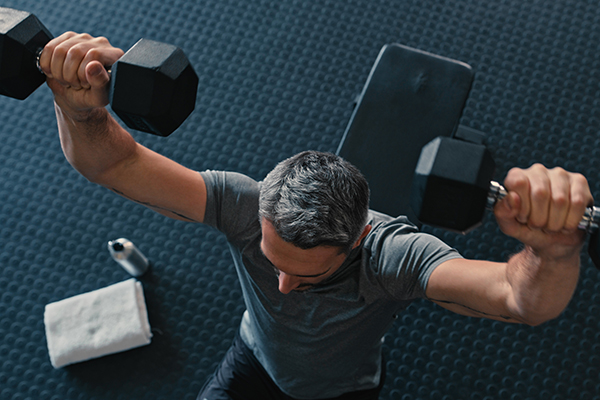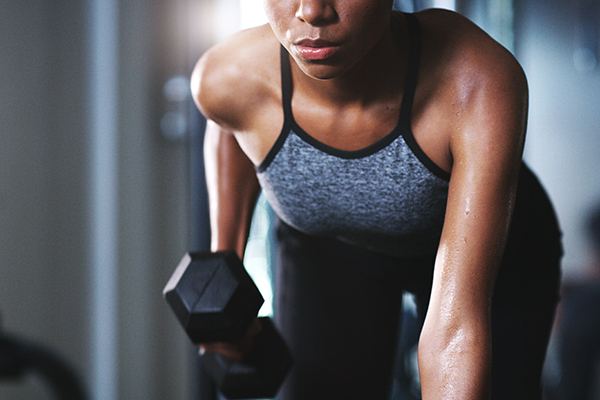Ever wonder why some people seem to get bigger and stronger with minimal effort, while others lift like maniacs and progress much more slowly?
Among many possible explanations — diet, sleep, the capriciousness of the muscle-building gods — one reason you hear often involves the variation in muscle fiber types between individuals.
Often oversimplified like much of fitness, muscle fibers are the stringy, contractile filaments that make up every muscle in your body.
There are several different varieties, but generally speaking, you only have to be concerned with two, imaginatively named type I and type II.
Type I fibers are smaller and more endurance-oriented while type II fibers are larger, stronger, and more powerful.
It’s long been clear that different people — and different muscles — have different proportions of these fiber types.
That’s led many fitness-minded folks to conclude that this must be why some lifters develop shoulders like halved cantaloupes, while others’ still look like Roma tomatoes.
But is that true? What do we know about these fiber types?
Are we in fact stuck with the proportions with which we were born, or can we change them?
And how can we apply what we know about fiber types to help us reach our fitness goals faster?
What Are the Two(-ish) Types of Muscle Fibers?
As mentioned above, there are two broad categories of muscle fiber — one with a subcategory — that differ based on their function, structure, and the type of fuel that primarily powers them.
Type I (“slow-twitch”) muscle fibers
Also known as “slow-oxidative” muscle fibers, these see the most action on a day-to-day basis.
They’re more reliant on oxygen (delivered via the bloodstream — hence that fancy “oxidative” moniker) in combination with fat or glycogen — a form of sugar stored in your liver and muscles — for energy production than type II fibers, and are good for low-to-moderate intensity steady-state activities such as walking, jogging, light resistance training, etc.
They’re also your smallest muscle fibers, and when stressed consistently with endurance-focused strength training, they tend to grow less than other fiber types.
Stress them with aerobic-type activity, however, and they’ll grow more mitochondria — the little powerhouses within each fiber where energy production occurs.
All of that makes them more geared towards endurance-oriented activities.
Type I fibers appear red under a microscope due to the presence of blood-carrying myoglobin, which helps shuttle oxygen into the cells.
Type II (“fast-twitch”) muscle fibers
There are two classifications of type II muscle fiber: Type IIa and Type IIx.
Type IIa: Also known as “intermediate fibers” or, for the science nerds among us, “fast-oxidative-glycolytic” fibers, type IIa’s jump into action when a task becomes too intense for type I fibers.
They also run on a combination of oxygen and glycogen, but while faster and stronger than type I fibers, they’re also considerably less energy efficient and quicker to fatigue.
Want to pound out a heavy set of presses, or sprint to catch a departing Uber? Fast-twitchers are the fibers for the job.
Since they require only minimal oxygen to function, type IIa fibers — and their more explosive cousins, the IIx’s — appear gray or white under a microscope.
Type IIx: A sub-category of fast-twitch fibers also known as “fast-glycolytic” fibers, these are the strongest, most powerful — and least energy efficient — fibers of all.
Mitochondria are scarce in IIx’s, as oxygen isn’t a primary driver of energy production in these fibers, which run almost entirely on glycogen.
When you’re going for a max-effort squat, broad jump, or 100-meter dash, your IIx fibers are best suited for the job.
Type IIx fibers are a little mysterious — among active people, less than 2 percent of fibers are pure type IIx.
In addition to these, there are also several “hybrid” fiber types that exist on the spectrum between the other major types. More on those in a minute.
What Primary Muscle Fiber Type Are You?
Given these basic descriptions, most fitness-inclined folks immediately have two questions:
“Am I more type I or type II?”
and
“How can I get more type IIs and grow bigger muscles?”
Answering the first question is more involved than you might think.
The only way to get a fully reliable answer is to biopsy your muscles, which involves having a lab technician take core samples of every major muscle in your body with a giant needle so he or she can analyze the relative proportion of different fiber types under a microscope.
Not a fun — or cost-effective — proposition.
Some fitness professionals have proposed that you can estimate your fast-twitch/slow-twitch ratio with performance tests.
For instance, lifting 80 to 85 percent of your one-rep max during an exercise for a given muscle group and seeing how many reps you can do.
“There are several problems with such tests,” says Trevor Thieme, C.S.C.S., Beachbody’s senior manager of fitness and nutrition content. “Not the least of which is the fact that how quickly you fatigue is directly influenced by how skilled you are at performing the exercise.”
In other words, your ability to perform a lift isn’t determined solely by the brute strength of the muscles being used; how proficient you are at the movement itself counts, too.
So that leaves you with a very unscientific approach: taking an educated guess.
“If you struggle to put on muscle but excel at endurance sports, you’re likely type-I dominant,” says Thieme.
“If you pack on muscle fairly easily and prefer pumping iron to pounding the pavement or spinning your wheels on a bike, you’re likely type-II dominant,” he adds.
Somewhere in between? That would put you … somewhere in between.
Can You Change Muscle Fiber Types?
So now, the burning question: with training, can you change your fiber type profile?
Ask most fitness pros this question and they’ll usually paraphrase the schoolteacher’s adage: “When it comes to fiber type,” they’ll tell you, “you get what you get, and you don’t get upset.”
But emerging research raises some questions about this oft-repeated fitness axiom.
Turns out muscle fibers do change type. All of the time. And rather quickly.
Research from Cal-State Fullerton demonstrates that the muscle fiber types of identical twins vary significantly, twin to twin, based on the individual’s choices of physical activities. Genes only tell part of the story.
Remember those hybrid fibers we talked about?
Those little buggers can comprise up to 40 percent of the muscle fibers of sedentary people — and are particularly susceptible to change.
With training, they can become ‘pure’ fiber types — type Is or a type IIs. And the more you train, the more they change to accommodate the demands you place on them.
Stop training and they become hybrids again.
Why the longstanding confusion over fiber-type conversion?
It comes down to advances in measuring: Only recently has it been possible to accurately categorize large numbers of individual muscle fibers and to distinguish hybrid fibers from pure types.
Once the guys in the white coats figured out how to count and categorize fibers accurately, the mystery was solved, according to Dr. Andy Galpin, PhD. a leading researcher in the field of fiber types.
Unfortunately for those of us looking for a clear-cut answer, this research leaves open the longstanding question of why some people gain muscle and strength relatively easily while others have a much harder time of it.
Many factors influence muscle growth, some genetic (e.g. bone structure, tendon length, and many more esoteric factors), others behavioral (e.g. sleep, stress, diet, and training).
But it looks like we can put to rest the longstanding misconception that fiber type is fate and that everyone is blessed or cursed with whatever muscle fiber composition they inherited at birth.
“While we’ve got countless more questions than answers at this point,” Galpin says, “we can comfortably say that not only do human skeletal muscle fiber types change, but it happens often, quickly, and in response to just about everything you do.”
Training by Fiber Type
So, if type I fibers tend to be more enduring, and type IIs stronger and faster, common sense would suggest:
To hit your slow-twitch, type I fibers: Train with higher reps and less weight (say, three to four sets of 12 to 15 reps using a weight that results in failure at the top end of the range).
To hit your fast-twitch, type II fibers: Train with lower reps and more weight (say, two to four sets of three to 12 reps).
You might even deduce that the “hypertrophy range” — eight to 12 reps — will effectively hit both types of fibers.
And as far as research currently indicates, common sense is more or less on target.
Though slow-twitch fibers are still active on heavy lifts, and some fast-twitch fibers help out towards the end of lighter sets, it’s still effective to perform sets that focus on the properties of each fiber type (e.g., heavy and fast or light and slow), particularly if you’re looking for muscle growth.
“It’s tough to recruit type II with light loads unless you lift explosively,” says exercise physiologist Dr. Chad Waterbury. “Doing a set of 25 or 30 reps to failure does not recruit the largest type II fibers.”
Conversely, he says, “To build type I fibers maximally you need higher-rep sets.”
Ideally, you’re performing those lighter sets to — or close to — muscular failure.
So if you’re looking for maximal muscle growth in your type IIa and IIx fibers, lift heavy — using weight you can lift maybe 12 times at most — the majority of the time, and throw in some explosive lifts (lifting a weight as fast as possible) when you can.
For your type I fibers, do some higher-rep sets (15 or more).
“It’s important that you include both lifting schemes in your training plan to optimize overall muscle growth,” says Thieme.
Worth noting: Different lifters respond differently to the various rep ranges.
So you may find that you get better results by skewing your training more heavily toward higher or lower reps.
This may or may not have to do with your dominant fiber type: You have naturally big muscles but still respond to higher reps, or are naturally lean and respond well to lower reps.
Sure Thing with Megan Davies is a fitness program that focuses on a science-based approach to fitness called “TYPE TRAINING.”
Megan alternates weekly between endurance and power-based strength training plus cardio conditioning to target both slow-twitch and fast-twitch muscle fibers.
TYPE TRAINING is an inclusive training protocol for a healthy, strong, balanced body. Learn more about Sure Thing here.





